State DOT Certification Programs for Materials Sampling and Testing Personnel (2025)
Chapter: 3 Survey Results
CHAPTER 3
Survey Results
This chapter presents the results of the survey that was sent to the AASHTO COMP voting members of each DOT. Responses were received from all 52 DOTs contacted (50 state DOTs, the District of Columbia DOT, and the Puerto Rico DOT), although not all questions were answered by all respondents. The complete survey questions are included in Appendix A, and complete survey results can be found in Appendix B. This chapter is a summary and discussion of the survey results.
The survey focused on aspects of the DOT certification programs that were directly related to materials acceptance sampling and testing in the areas of soils, aggregate, asphalt mixture, and concrete. The survey included instructions to consider the lowest level of certification when answering a question (i.e., base answers on Level 1 requirements whether there is a Level 1 and Level 2 certification). In some questions, the different materials areas were separated so that different answers could be supplied for the different materials. On those questions there may be a range of values provided instead of just one. Most programs were found to be nuanced; therefore a 25- to 30-question survey provides a high level of information. The survey intended to gather basic information on the programs, and this information was supplemented with a review of websites and other online documentation.
The survey includes the following areas:
- Program Administration
- Program Specifics
- Other
The Program Administration section covers the management of the program, who manages the technician certification program and how, and how certification information is shared. The Program Specifics section includes the training and exams that are used as part of certification, along with the use of outside certifications in the DOT program. The Program Specifics section also contains aspects such as the volume of certifications, recertification requirements, recertification and decertification processes, and laboratory technician requirements. The Other section identifies additional certifications included in the DOT’s program, as well as their IA approach.
The survey consisted of 25 questions, with six possible subsequent questions (questions 8a, 9a, and 15a through 15d). The opening questions (1 and 2) were used to identify the responding DOT and the respondent. Only the responding DOT is identified in this synthesis. Question 3 related to the terms qualification and certification as used by the DOT to describe their program.
Question 3: Does this DOT use the term qualified, certified, or both to describe the personnel who are approved to perform sampling and testing according to the requirements of 23 CFR 637 Subpart B? (select one). Responses are summarized in Figure 4.

As noted in Chapter 2, 23 CFR 637B requires DOTs to use qualified personnel, with the DOT defining what it means to be qualified. Most DOTs indicated they use the term certified, though a few use qualified. Eleven DOTs use both terms interchangeably. The six DOTs that indicated they use the term qualified (Florida, Hawaii, Idaho, Indiana, Kentucky, and Rhode Island) are somewhat dispersed geographically, as shown in Figure 5. (Note: Alaska, Hawaii, and Puerto Rico are all shown below the U.S. mainland in the map figure from left to right, respectively.)
Based on a review of the DOTs that selected qualified in response to question 3, their documentation does include the term certification, but typically only in relation to outside certifications such as ACI-CFT Grade 1, not the DOT’s sampling and testing program certifications.
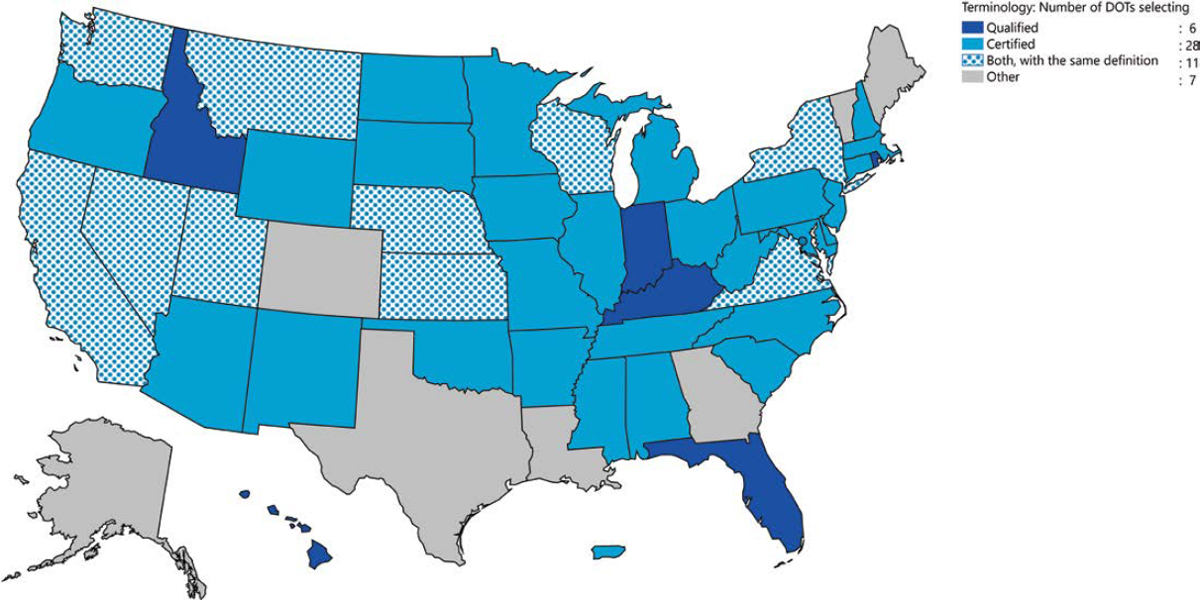
Most DOTs that chose Other in response to question 3 indicated that they recognized both terms to describe the personnel who are approved to perform sampling and testing, but they do not use the terms interchangeably. They used qualified for internal, not external, technicians. The complete answers related to Other responses can be found in Appendix B.
To prevent confusion in the survey, the terms qualified/certified and qualification/certification were used throughout, and the respondent was asked to consider it the same as the term used by their DOT. The terms DOT certified or certified are used everywhere in this synthesis with the exception of this chapter, in which the terms qualified and certified are both used.
Program Administration
Who is involved in the administration of the DOT’s certification programs, and how, varies. Most DOTs indicated that they manage the program (over 40 of the 52 DOTs, or about 77 percent). Some also identified outside associations (11–23 of 52, or 21–44 percent). A lesser number also identified colleges or universities (9–14 of 52, or 17–27 percent) as part of program management. The value ranges (11–23 and 9–14) reflect responses related to the specific material type. The survey respondents were asked to respond separately to the program administration question as related to soils, aggregate, asphalt mixture, and concrete acceptance sampling and testing, so the values can vary by material type. The use of outside associations in program management was the highest for concrete materials (44 percent), and the use of college or universities in program management was highest for asphalt materials (27 percent). Respondents were further instructed to consider the lowest level of certification when answering a question. Some certification programs were found to have different requirements for different levels of certification in the individual state website review, so the different levels may also be managed differently.
General Information
Survey questions 4 and 5 were used to gather information on the DOT’s program documentation.
Question 4: Does the DOT have a website for the DOT’s qualified/certified testing technician program? The complete results and website URLs are shown in Appendix B, Table B3. Question 5 allowed for uploading documents. Of the 52 DOTs surveyed, 42 provided URLs. Thirty (71 percent) of those that provided URLs identified a portion of the DOT website; five (12 percent) identified the web address for an organization; three (7 percent) identified a college website, and three (7 percent) identified a private website. The remaining 10 of the 52 DOTs (19 percent) did not list a website, but several that did not identify a website did provide documents. Figure 6 shows the geographical distribution of website domains.
Management
Question 6: Who is involved in the daily management of the qualification/certification program for the different material areas? (select all that apply). Choices included: DOT, Outside Contractor/Consultant, LTAP (Local Technical Assistance Program), College/University, Outside Association (e.g., APA, ACI) and Other. Table 2 shows the number and percentage of DOTs that selected a specific entity (top row) for each of the materials shown (first column). No DOT selected all entities for any material.
Of 52 responses, 16 DOTs (31 percent) identified only the DOT as the program manager for all four materials. Only two DOTs (4 percent)—Nebraska and the District of Columbia—chose LTAP. Nebraska identified LTAP for all materials except concrete; the District of Columbia noted LTAP for asphalt mixture only. One DOT (2 percent)—Maine (part of NETTCP)—chose Other along with Outside Association.
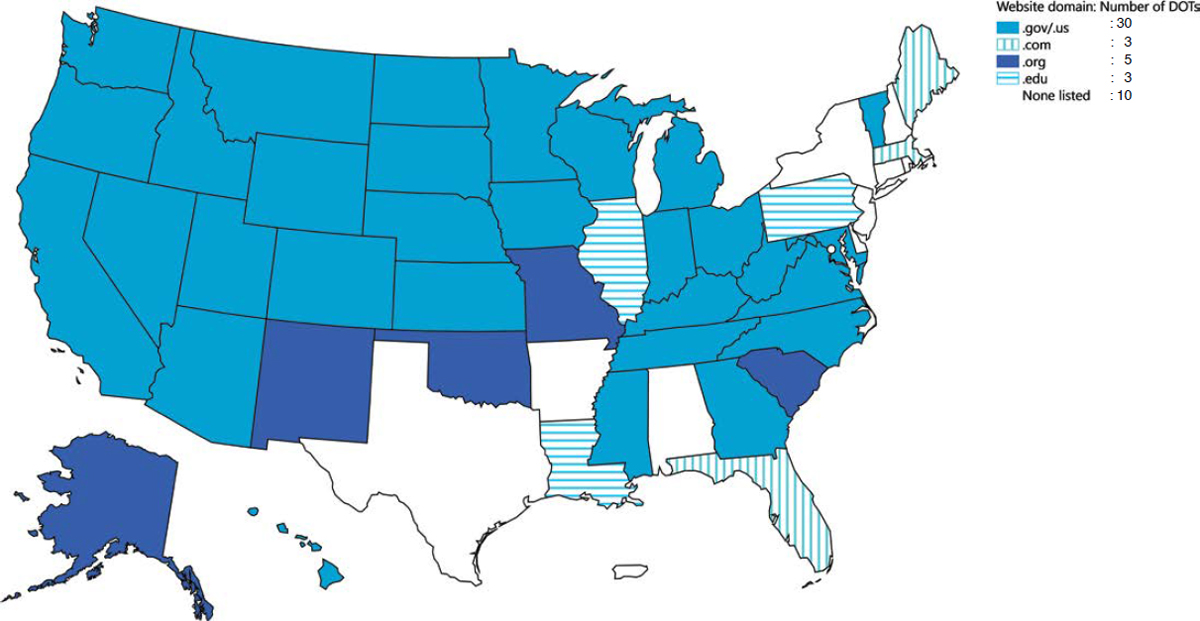
Types of Personnel Certified
Question 7: Who is required by the DOT to be qualified/certified in these materials areas? (select all that apply). Results are summarized in Table 3 by materials area. The table shows the number and percentage of DOTs that selected a specific entity for each of the materials shown (first column).
The answers show that the predominate users of the certification program are the DOT personnel themselves, followed by consultants. More than half of the DOTs indicated that contractors are those who must meet this requirement—for all materials except soils. Asphalt mixture had the highest number of contractor responses, potentially due to the proliferation of contractor QC samples being used in the acceptance program in the asphalt industry. Five DOTs (10 percent) selected only DOT for all materials (Delaware, Louisiana, Maine, Montana, and Puerto Rico).
Table 2. Question 6: Program management by material area.
| DOT | Outside Contractor/Consultant | LTAP | College/University | Outside Association (e.g., APA ACI) | Other | ||
| Soils | 46 88% |
9 17% |
1 2% |
9 17% |
11 21% |
1 2% |
of 52 DOTs % of DOTs |
| Aggregate | 44 85% |
7 13% |
1 2% |
10 19% |
15 29% |
1 2% |
of 52 DOTs % of DOTs |
| Asphalt Mixture | 42 81% |
8 15% |
2 4% |
14 27% |
16 31% |
1 2% |
of 52 DOTs % of DOTs |
| Concrete | 41 79% |
7 13% |
0 0% |
10 19% |
23 44% |
1 2% |
of 52 DOTs % of DOTs |
Table 3. Question 7: Personnel subject to certification.
| DOT | Consultant | Contractor | Supplier | Local Government | ||
| Soils | 48 92% |
43 83% |
24 46% |
6 11.5% |
11 21% |
of 52 DOTs % of DOTs |
| Aggregate | 51 98% |
43 83% |
29 56% |
22 42% |
11 21% |
of 52 DOTs % of DOTs |
| Asphalt Mixture | 52 100% |
46 88.5% |
38 73% |
26 50% |
13 25% |
of 52 DOTs % of DOTs |
| Concrete | 51 98% |
47 90% |
34 65% |
24 46% |
14 27% |
of 52 DOTs % of DOTs |
Timeframe
Considering that many DOTs would have a consistent timeframe for their certifications, Question 8 was asked in two parts.
Question 8: Is there a consistent timeframe qualifications/certifications are valid [i.e., the same for all the main material types (Soils, Aggregate, Asphalt Mixture, Concrete)]? Responses are summarized in Figure 7. As expected, the majority (81 percent) responded that the timeframe was consistent, with 5 years being the most common (35 DOTs), 3 years being next (five DOTs), and the remainder noting 2 years (one DOT) and 4 years (one DOT). Current FHWA guidelines have a recertification timeframe of 3 to 5 years.
The DOTS that did vary the certification timeframe by material provided the values by material in response to Question 8a, but there was no consistent variation. The complete results for Questions 8 and 8a are shown in Appendix B, Table B6.
Outside Technicians
Question 9 addressed differences by type of applicant.
Question 9: If the DOT program includes technicians outside the DOT, is the qualification/certification process the same for DOT personnel and the other technicians? Responses are
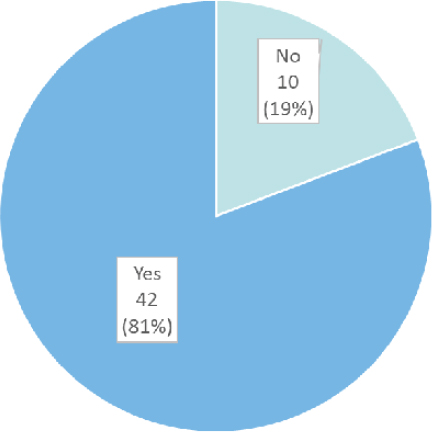
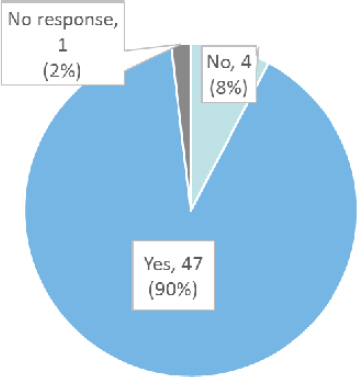
summarized in Figure 8. As shown, most DOTs (90 percent) did not specifically differentiate. The DOT that did not respond also did not identify requiring anyone but DOT personnel to be certified in response to Question 7, therefore that DOT would also not have a different process, bringing the total to 48 of 52 (92 percent) of DOTs that do not treat DOT technicians and other technicians differently.
The four DOTs that responded “No” were asked to respond to Question 9a.
Question 9a: Select how the qualification/certification process is different (select all that apply). Responses are summarized in Figure 9. The figure shows the four choices presented for the question and the responses of the four DOTs that selected No on Question 9.
In addition to the choices presented, there was also an option to select Other and to clarify that choice. Texas and Vermont both chose Other; Texas indicated that the difference is only for concrete, and Vermont stated that external technicians must be certified, while internal technicians may only be qualified.

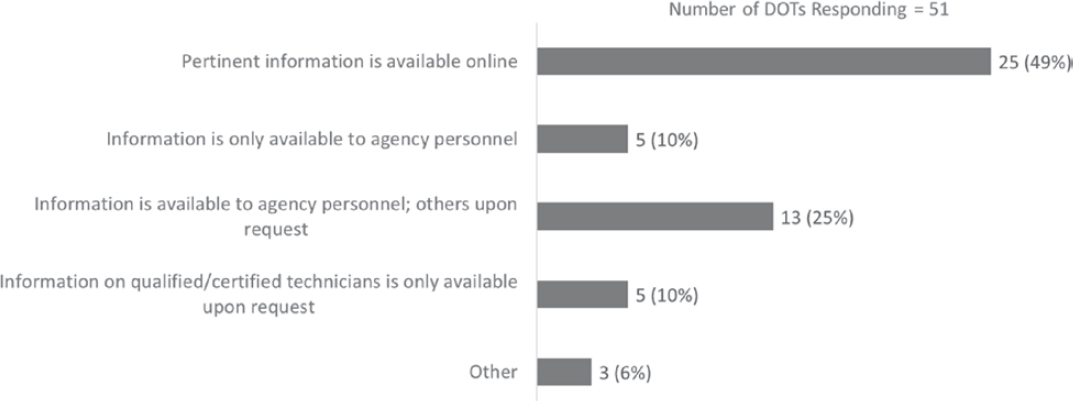
Sharing Certification Information
Question 10: How is the technician qualified/certified personnel list/database information shared? (select one). Responses are summarized in Figure 10. Survey respondents were given one of five options for how the technician certification program information was shared. About half of the DOTs noted that pertinent information was available online. Other responses noted that the answer depended upon the material or whether the technician was internal or external, and one DOT noted that certified personnel information was available to the DOT and consultants in AASHTOWare Project.
Program Specifics
The next portion of the survey focused on specifics of the program, such as training, certification requirements, and how certification exams were developed.
Training Program—Management and Components
As with the management of the program itself, the management of training programs varied. Most of the DOTs identified a training program as part of the certification program.
Question 11: Does the DOT have a training program associated with the qualification/certification program in these materials areas, and how is it managed? (select one for each material). Responses are summarized in Table 4. The table shows the number and percentage of DOTs that selected a specific entity for each of the materials shown (first column). Question 11 attempted to determine whether the DOT has a training program and how it is managed. The DOT is involved in the management of the training program for most of the DOTs (30–34 DOTs, or 58–65 percent, depending on the material area). Outside Association (e.g., APA, ACI) was the most chosen response for concrete; in 10 responses (19 percent) Outside Association was selected in conjunction with DOT; and in 13 cases (25 percent) Outside Association was the only entity selected for concrete.
The Indiana and Maine DOTs indicated that they did not have a training program for any of the material areas. The Indiana DOT’s website identified certification programs in conjunction with industry (Indiana Mineral Aggregates Association and APA of Indiana), and these industry
Table 4. Question 11: Training program management.
| DOT | Outside Contractor/Consultant | LTAP | College/University | Outside Association (e.g., APA, ACI) | Other | No Training Program | ||
| Soils | 34 65% |
5 10% |
1 2% |
9 17% |
9 17% |
0 0.0% |
3 6% |
of 52 DOTs % of DOTs |
| Aggregate | 31 60% |
4 8% |
1 2% |
9 17% |
15 29% |
0 0.0% |
3 6% |
of 52 DOTs % of DOTs |
| Asphalt Mixture | 31 60% |
5 10% |
2 4% |
12 23% |
14 27% |
0 0.0% |
2 4% |
of 52 DOTs % of DOTs |
| Concrete | 30 58% |
4 8% |
1 2% |
8 15% |
23 44% |
0 0.0% |
4 8% |
of 52 DOTs % of DOTs |
websites listed training. Maine DOT is a member of NETTCP, which includes training within the certification program.
Question 12: For the areas that the DOT has a training program, does it include these components? (select all that apply, leave blank if no training program for the material). Responses are summarized in Table 5. In-person training with exams were the most predominate answer. Of 52 responses, 14 DOTs (27 percent) identified Online Training for all four material categories (Arkansas, Connecticut, Hawaii, Iowa, Kentucky, Louisiana, Michigan, Minnesota, Montana, North Dakota, Rhode Island, South Dakota, Texas, and Wisconsin). The DOTs that noted TC3 (currently AASHTO Technical Training Solutions) or NHI training included Connecticut, Georgia, Rhode Island, New Jersey, and Wisconsin. The DOTs that identified Seasonal/Just-in-Time training were northern states (colder climates) and California.
Requirements and Outside Certifications
Question 13: What steps are required to obtain an initial qualification/certification in each area? (select all that apply). Responses are summarized in Table 6. Written Exam and Performance Exam were the most often selected for all material types. OJT is required by 13–16 of 52 DOTs (25–31 percent) depending upon the material area.
Table 5. Question 12: Components of training programs.
| In-person Training | Online Training | TC3 or NHI Training | Seasonal/Just-in-Time Training | Exam Included as Part of Training | Fees Associated with Training | ||
| Soils | 42 81% |
20 38% |
4 8% |
6 12% |
35 67% |
25 48% |
of 52 DOTs % of DOTs |
| Aggregate | 43 83% |
20 38% |
5 10% |
6 12% |
34 65% |
28 54% |
of 52 DOTs % of DOTs |
| Asphalt Mixture | 43 83% |
17 33% |
5 10% |
5 10% |
37 71% |
28 54% |
of 52 DOTs % of DOTs |
| Concrete | 42 81% |
19 37% |
3 6% |
7 13% |
36 69% |
26 50% |
of 52 DOTs % of DOTs |
Table 6. Question 13: Steps required for initial certifications.
| Classroom or Online Training | Hands-on/Performance Training | OJT Training/Work Experience | Written Exam | Performance Exam | Fees for Training and/or Exams | Other | ||
| Soils | 36 69% |
30 58% |
15 29% |
46 88% |
42 81% |
35 67% |
1 2% |
of 52 DOTs % of DOTs |
| Aggregate | 39 75% |
34 65% |
14 27% |
48 92% |
46 88% |
39 75% |
1 2% |
of 52 DOTs % of DOTs |
| Asphalt Mixture | 41 79% |
33 63% |
16 31% |
49 94% |
43 82% |
39 75% |
1 2% |
of 52 DOTs % of DOTs |
| Concrete | 40 77% |
36 69% |
13 25% |
49 94% |
47 90% |
39 75% |
1 2% |
of 52 DOTs % of DOTs |
Question 14: Does the DOT accept or require these outside certifications as part of the DOT qualification/certification program? (select one choice for each outside certification/row). Responses are summarized in Table 7. The sum of the rows does not total 52 because some DOTs did not respond to portions of the question. The percentage of DOTs is based on the number of DOTs responding. For the responses shown, Do Not Formally Recognize was the most frequently selected choice for every type of program except ACI.
Table 7. Question 14: Outside certifications recognized.
| Accepted with No Other Requirements | Accepted with Additional Requirements | Required for Qualification/Certification with No Additional Requirements | Required for Qualification/Certification with Additional Requirements | Do Not Formally Recognize | ||
| Another DOT’s Program (Reciprocity) | 6 13% |
11 24% |
0 0% |
1 2% |
28 61% |
of 46 DOTs % of DOTs |
| A Regional Program (e.g., MARTCP, NETTCP) | 11 23% |
3 6% |
3 6% |
1 2% |
30 62% |
of 48 DOTs % of DOTs |
| ACI | 26 50% |
11 21% |
6 12% |
6 12% |
3 6% |
of 52 DOTs % of DOTs |
| AI, NCAT | 5 11% |
4 9% |
0 0% |
2 5% |
33 75% |
of 44 DOTs % of DOTs |
| NICET | 5 12% |
3 7% |
0 0% |
0 0% |
35 81% |
of 43 DOTs % of DOTs |
| Local Association Chapter (e.g., APA, ACPA) | 4 9% |
2 4% |
2 4% |
1 2% |
36 80% |
of 45 DOTs % of DOTs |
Exams
Question 15: What types of questions are generally used in the DOT-specific (i.e., not NICET or ACI) qualification/certification written exams? (select all that apply). Results are summarized in Figure 11. Question 15 included subsequent questions depending on the original answer. The survey skipped questions 15a through 15d only if the last selection (No Written Exams) was the only one chosen.
Of 50 responses, five DOTs (10 percent) selected No Written Exam as their only answer, and four of these five are associated with either NETTCP or MARTCP, so it is expected that the certification for the DOT does require an exam that is not performed by the DOT. The fifth DOT also selected some of the other choices, so the wording of the question may not have been clear. Of the DOTs that did not select No Written Exam, multiple choice was the most common answer (selected by 46 DOTs, or 92 percent), while 25 of those 46 DOTs also selected both Fill In the Blank and True/False. Only five DOTs (10 percent) selected Essay, but four of those five also selected all five question types. The DOTs that selected Questions on State Specifications are shown geographically in Figure 12. The use of state specifications in exams may be a complication in reciprocity.
If respondents chose an answer indicating that the DOT was involved in preparing exams, they were also asked questions 15a, 15b, and 15c, which went into more detail on the exams.
Question 15a: How are the questions developed for the DOT written exams? (select all that apply). Results are summarized in Figure 13.
Eighty percent (36 DOTs) of the 45 responding DOTs noted that they develop exam questions in-house. Of the DOTs that selected “College/University,” five of the eight also selected “DOT.” Similarly, seven of the nine that selected “outside consultant” also selected “DOT.” Two DOTs selected all three choices (“in-house,” “college/university,” and “outside consultant”).
Question 15b: How often are the qualification/certification written exams reviewed and revised or updated? (select one) Results are summarized in Figure 14.
Question 15c: What types of technology does the DOT use to administer written exams? (select all that apply). Results are summarized in Figure 15. Of the responding DOTs, 73 percent (33 of 45) conduct exams in-house using pen and paper, and 19 of the 33 also identified other options. No DOT identified using all five options.
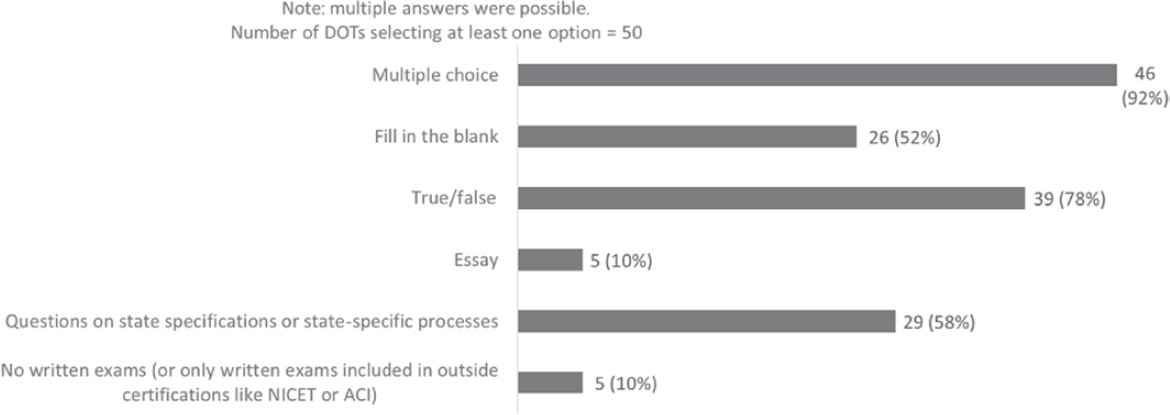
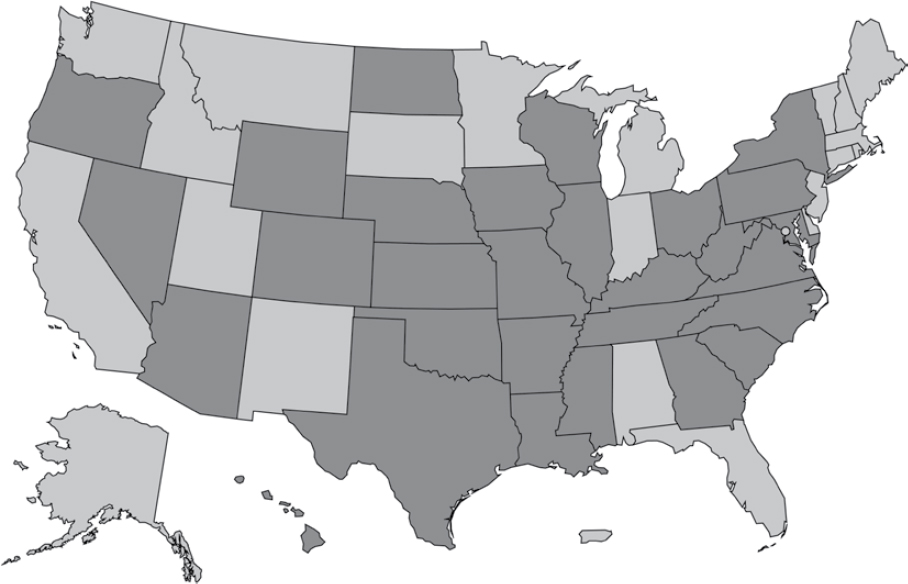
Online Testing Platform and Testing Centers were options selected by 73 percent (33 DOTs) combined. Use of technology for delivering exams is explored further in Chapter 4.
Question 15d: Who has access to the exam questions and completed student exams? (select all that apply). Results are summarized in Figure 16.
Eighty percent of the responding DOTs (36 of 45) stated that access to the written exam questions is available to in-house DOT personnel only. There were multiple answers possible; of the remaining selections, 36 percent (16 DOTs) selected College/University. Program Contractor/Consultant Personnel was selected by 24 percent (11 DOTs).
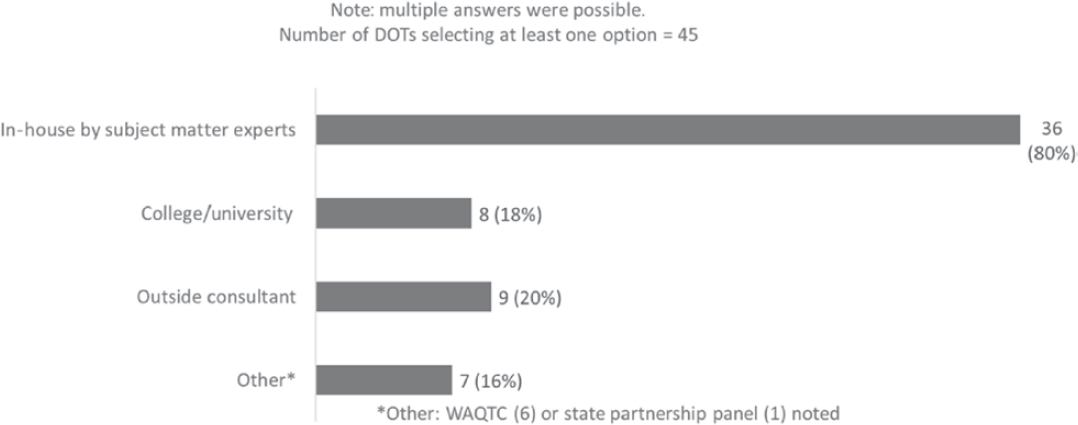
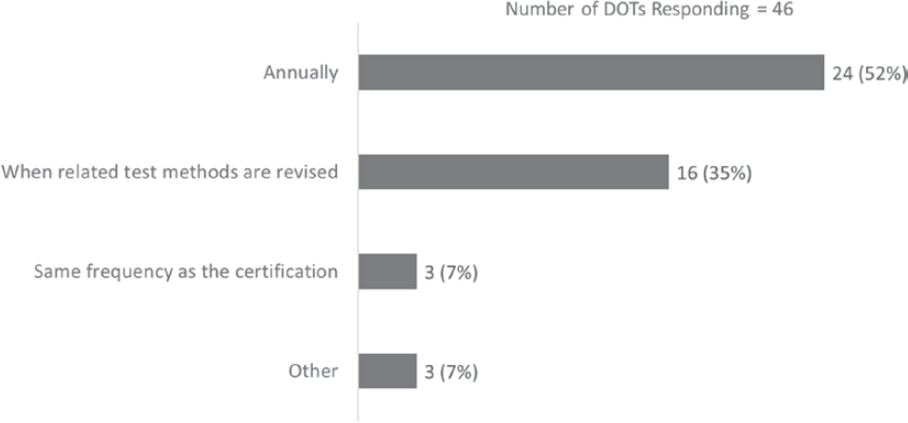
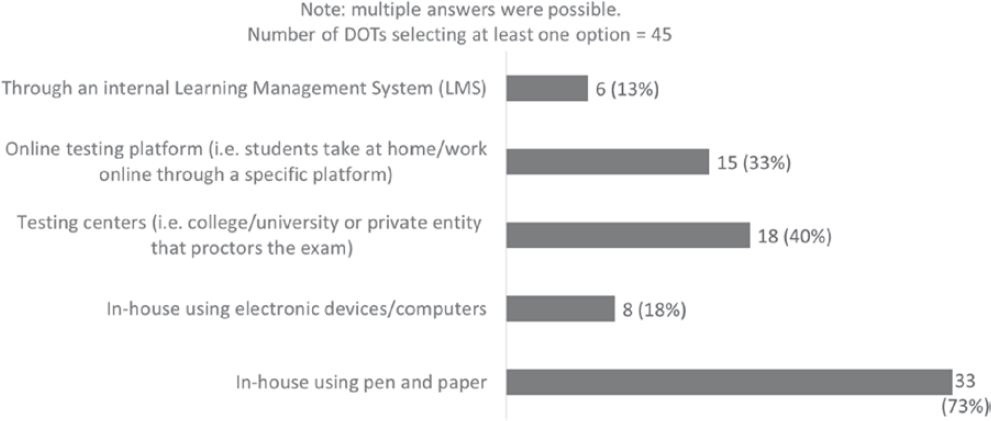

Other
Volume
To estimate the volume of certifications processed by a DOT, the survey asked for an approximate number of certifications and recertifications handled by the program in a year. The respondent was given the option to add a value for each or an estimated total value. Forty-two respondents provided a value. Of the DOTs that did not respond with a value, one noted that they did not perform any in-house certifications.
Question 16: How many materials testing qualification/certifications are issued by this DOT in a year? (approximately). The map in Figure 17 provides a geographical view for the different values (combining the initial and recertification values if provided separately). The highest value was 16,600 from California. Some answers provided ranges instead of values; in those cases the map value uses the average value from the range provided. The actual values reported are presented in Appendix B, Table B14.
Question 17 sought to determine whether the DOT was able to support the volume of certifications being requested.
Question 17: Has the DOT program been able to meet the demands of testing personnel requiring qualification/certification in the last 2 years? Responses are summarized in Figure 18. There was a concern that issues related to the COVID-19 pandemic would affect the answer to this question. In order to minimize this effect, the question specifically inquired about the previous 2 years. Out of 51 responses, 47 DOTs (93 percent) responded affirmatively, indicating that they were able to meet the demands.
Recertification and Decertification
Question 18: What elements are used and/or required as part of the DOT requalification/recertification? (select all that apply). Responses are summarized in Table 8. Like Question 13, which is related to initial certification requirements, Written Exam and Performance Exam were the most frequently chosen options for all materials. A lower number of DOTs selected
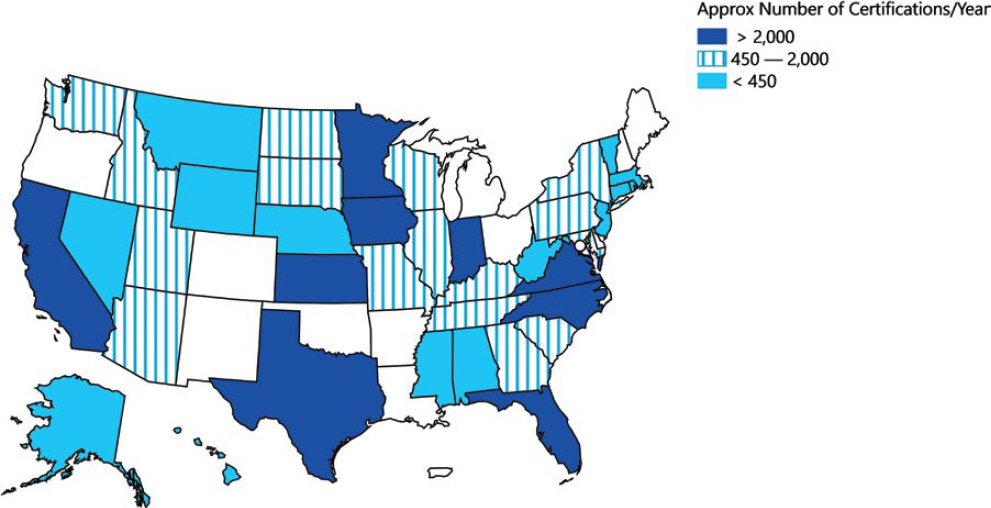

Classroom or Online Training for recertification (26–30 DOTs, or 50–58 percent) depending on material area than did so for the initial certification (36–41 DOTs, or 69–79 percent) that was asked about in Question 13.
Questions 19 and 20 addressed decertification and appeal processes. Most of the DOTs (42 and 36, respectively) responded affirmatively to both of these questions.
Question 19: Does the DOT have a de-qualification/decertification process for technicians? Responses are summarized in Figure 19.
Question 20: Is there an appeal process for de-qualified/decertified technicians? Responses are summarized in Figure 20.
Laboratory Personnel Certification
Question 21: Does the DOT have a unique section of the Quality Management System (QMS) for laboratory technicians (something that goes beyond the AASHTO R 18 Section 5.5
Table 8. Question 18: Elements used in recertification.
| Classroom or Online Training | Generic Continuing Education in the Area | IA Testing | Work Experience | Written Exam | Perf. Exam | Fees for Training and/or Exams | No Process | ||
| Soils | 26 50% |
1 2% |
17 33% |
4 8% |
42 81% |
37 71% |
28 54% |
2 4% |
of 52 DOTs % of DOTs |
| Aggregate | 28 54% |
3 6% |
17 33% |
5 10% |
44 85% |
38 73% |
33 63% |
0 0.0% |
of 52 DOTs % of DOTs |
| Asphalt Mixtures | 29 56% |
3 6% |
19 37% |
5 10% |
45 87% |
38 73% |
34 65% |
0 0.0% |
of 52 DOTs % of DOTs |
| Concrete | 30 58% |
1 2% |
18 35% |
3 6% |
47 90% |
40 77% |
36 69% |
0 0.0% |
of 52 DOTs % of DOTs |

Technician Training and Evaluation requirements) that could be shared with others? Responses are summarized in Figure 21. As noted in Chapter 2, AASHTO R 18 has some basic requirements for technician training and evaluation that include performance examinations but does not require written exams or certifications for laboratory technicians. It was found that DOTs do have certification programs that include laboratory technicians. Based on the high level of negative responses to this question, DOTs may not consider their use of lab certifications as unique.
Question 23: What other types of qualifications/certifications (beyond the standard Soils, Aggregate, Asphalt Mixtures, and Concrete) are included in the DOT’s program? (select all that apply). Responses are summarized in Figure 22. At least one option was selected by 47 of 52 DOTs. In discussion with at least one DOT, it was found that the DOT took the term plant to mean certification of the plant and not necessarily the individual technicians in the plant. Discussion of these certifications, along with other certifications found as part of the literature review, is included in Chapter 6.
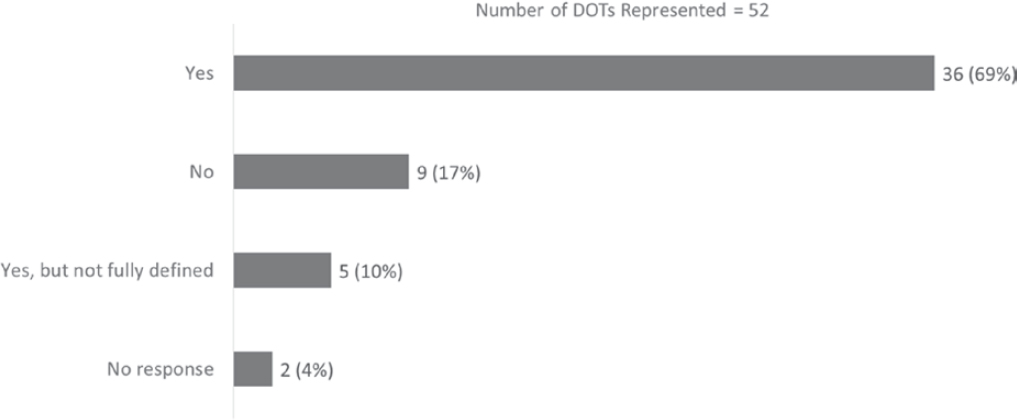
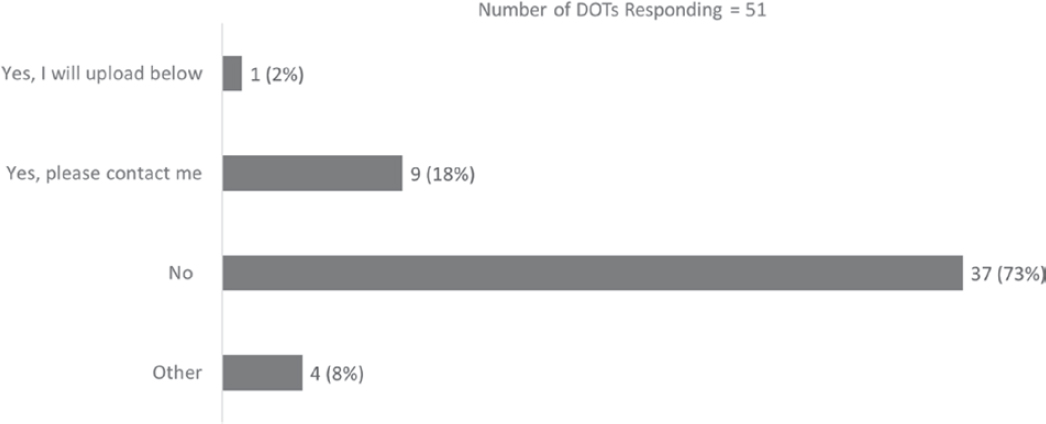
Independent Assurance
Question 24: What approach does the DOT use for independent assurance? (select one). Responses are summarized in Figure 23.
Question 25: We would like to interview selected DOT respondents for use in developing case examples. Case examples will be included in the final synthesis report. The case example DOTs will be identified, but the interviewees will remain anonymous. DOTs will have the opportunity to review their case examples for accuracy. Case example interviews typically last for 1 hour. Would your DOT like to participate in a case study interview? Responses are included in Appendix B. Most of the DOTs (38 of 52 DOTs, 73 percent) agreed to participate in a case example interview or provided another contact. Chapter 4 discusses the case examples that were developed with the assistance of some of these DOTs.
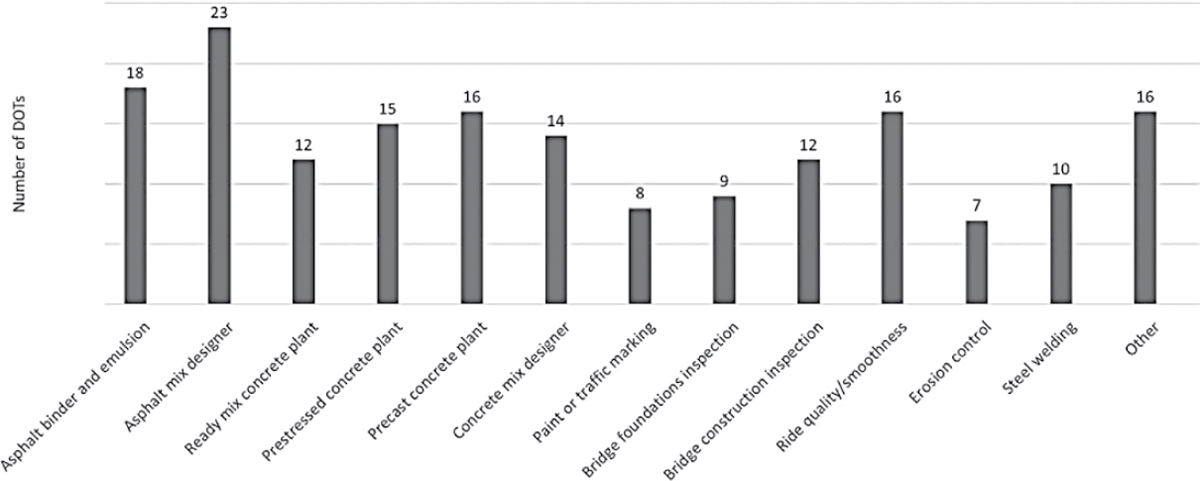

Survey Results Summary
Responses were received from all 52 of the DOTs contacted. The complete survey questions are included in Appendix A, and complete survey results are included in Appendix B.
The survey focused on aspects of the DOT certification programs that were directly related to acceptance sampling and testing in the materials areas of soils, aggregate, asphalt mixture, and concrete. Programs were found to be nuanced, therefore a 25- to 30-question survey provides a high level of information. The survey intended to gather basic information on the programs.
Of 52 DOTs surveyed, 39 DOTs (75 percent) indicated that they use the term certified or use both certified and qualified with the same meaning. Only six (12 percent) indicated that they use only the term qualified.
Program Administration
The majority of those surveyed indicated that the administration of the certification programs had the following in common:
- DOT manages the certification program: 41–46 of 52 DOTs, or 79–88 percent (material specific)
- Certifications are based on a consistent timeframe: 42 of 52 DOTs, or 81 percent
- Consistent timeframe for certifications is 5 years: 35 of 52 DOTs, or 67 percent
- Certification processes are the same for DOT personnel and technicians outside the DOT: 48 of 52 DOTs, or 92 percent
- Pertinent certification information is shared online: 25 of 51 DOTs, or 49 percent (there were five options; the remaining 26 responses were scattered among the remaining four options)
Program Specifics
The majority of those surveyed (over 50 percent) indicated that their certification program does the following:
- Accepts or requires ACI-CFT Grade 1 certification but may have additional requirements: 49 out of 52 DOTs, or 94 percent
- Employs written exams: 46–49 of 52 DOTs, or 88–94 percent (material specific)
- Develops written exams in-house: 36 of 45 DOTs, or 80 percent
- Requires performance exams: 42–47 of 52 DOTs, or 81 to 90 percent (material specific)
- Revises written exams annually: 24 of 46 DOTs, or 52 percent
Other
The majority of those surveyed indicated that their certification program:
- Was able to meet the demands of testing personnel requiring certification: 47 of 51 DOTs, or 92 percent; and
- Has a decertification program with an appeal process: 42 of 52 DOTs, or 81 percent.
Chapter 4 looks in more depth at the certification programs of 10 different DOTs. Chapter 5 combines the survey results and the DOT website review to go into more detail by topic.

















